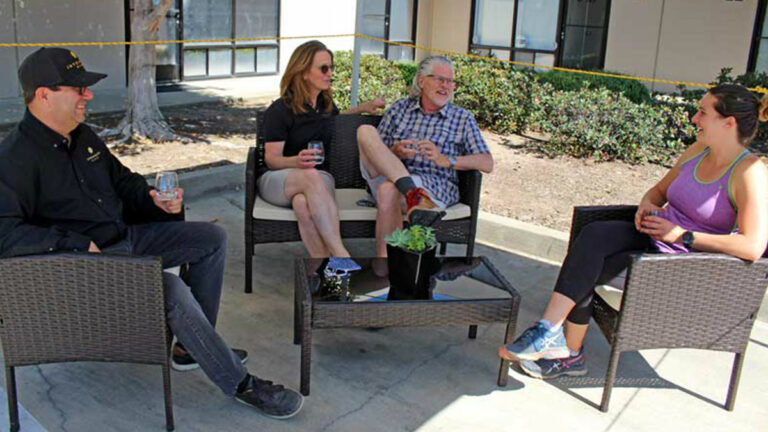This story is part one of a series on housing. — Editor
A new housing project has the potential to reshape the future of downtown Santa Cruz and the town’s relationship with the San Lorenzo River.
Years in the making, the much-anticipated SC Riverfront project has been slowly wending its way through the city’s planning department like a heron drifting across a coastal lagoon.
The Riverfront proposal is not exactly a modest concept. It would combine five separate parcels and provide a massive facelift to the area, removing three heritage trees in the process. Made up of three separate buildings, the project would loom large, with all three of its buildings topping out at 78 feet—still 17 feet shorter than the nearby historic Palomar Inn. Near the western banks of the San Lorenzo River, the project would stretch from 508 Front Street—now home to the I Love Sushi restaurant—to 418 Front Street, which now houses the 418 Project and India Joze. Developer Owen Lawlor is in contact with the 418 dance studio about reserving a spot for it in one of its proposed new buildings.
The development is in line with the 2003 San Lorenzo Urban River Plan (SLURP), Santa Cruz city planners say. It would increase access to the river and activity along the levee, creating civic spaces and staircases leading from Front Street to the Santa Cruz Riverwalk.
Above a first-floor retail level would be six stories of housing. The building is higher than the zoning in parcel would typically permit. Under normal circumstances, the development would be a 133-condominium project. But to get an allowance for additional height, Lawlor agreed to make 11% of those units—15 condominiums—available to very-low-income renters. In exchange, Lawlor gets the opportunity to raise the height and add more than 40 additional units under state density bonus rules, explains Planning Director Lee Butler. (Lawlor says he plans to rent the Riverfront condos out, rather than selling them off, at least at first.)
On top of that, Lawlor is proposing to build five additional affordable units. And Butler says that the 20-unit total satisfies the overlapping affordability requirements laid out by both the city and the state.
There’s just one small problem with that assessment: A majority of Santa Cruz planning commissioners disagree with it. They don’t think the rules overlap at all. The commissioners want to see if they can force Lawlor to meet both the local and state requirements, each as a separate law—essentially stacking one requirement on top of the other.
Butler warned last month that this approach might not fly in court, according to legal experts he consulted. Butler checked with both Santa Cruz City Attorney Tony Condotti and with attorney Barbara Kautz, who argued a case on behalf of Napa County and lost. Both attorneys said that stacking the state and local requirements conflicts with existing law.
Nonetheless, when approving the project, the Planning Commission voted 4-2 on Sept. 3 to stack the local and state requirements.
If the commissioners are right and their recommendation survives possible legal challenges, they could force Lawlor to make an extra 14 or 15 of his units affordable. If they’re wrong, their approach could push the city into a costly legal battle or sink a popular project that all the commissioners say they support.
When asked if he can afford to provide those extra affordable units, Lawlor initially bristles at the question.
The law is clear, he insists: The project in his application aligns with state law and the Planning Commission’s recent recommendation does not, he believes. Lawlor adds that, amid a pandemic and financial uncertainty across the globe, he isn’t sure his own version of the project will pencil out—even without the commission’s more stringent interpretation.
“We’re not sure if we’ll be able make the project work, anyway,” he says. “This could definitely sink the project.”
RIVER AGAIN
Planning Chair Andy Schiffrin says he believes the specifics of Santa Cruz’s housing affordability rules make it different from Napa County for a few reasons.
Among them is the fact that Santa Cruz’s housing affordability rules are quite old, and that voters approved the rules themselves some 40 years ago. By contrast, the Napa County Board of Supervisors waited until the state density bonus was taking effect in 2010 to hastily pass its own affordability requirements—which a judge ruled could not be stacked on top of the density bonus. But the distinctions are significant, Schiffrin argues.
Former County Supervisor Gary Patton, a frequent critic of development plans, agrees with Schiffrin’s interpretation of housing affordability law here. Councilmember Sandy Brown is interested in the concept and thinks that Santa Cruz should explore it.
In general, Schiffrin is skeptical when developers tell him or the people of Santa Cruz that they can’t make a project pencil out financially. He admits, nonetheless, that his interpretation could make it tougher for at least some developers to build high-density housing, at least at first.
“Will it be a hardship for developers? Will it make it make it more difficult? For sure,” says Schiffrin, who thinks the city should always be willing to go to court to defend a good policy—no matter the circumstances. “But we have so few resources for housing right now.”
Schiffrin says there are only so many parcels, mostly in the downtown area, that are suitable for high-density housing. That makes such land an especially valuable resource, he says. And if necessary, he feels the city should be willing to let special plots sit a while, as it awaits the right project.
There are properties in other parts of town that are potentially developable—including along the town’s busiest streets.
The most recent version of the Santa Cruz General Plan called for increased housing density along Santa Cruz’s bus corridors, like Soquel Avenue and Water Street. But Schiffrin thinks taller apartment buildings in those areas would change the town and “destroy the quality of life,” so he opposes them. (Partly with his nudging, the City Council essentially axed its corridor plan last year.)
In a dissenting vote on the Riverfront project last month, Planning Commissioner Julie Conway said Schiffrin’s approach would be a mistake, given the likelihood that Santa Cruz would lose.
“That has been refuted more and more clearly every single time it’s been tested. And I think we put the city in a terrible position, if we were to do something contrary to where we know where it would land in court,” said Conway, who works as the housing program manager for Santa Cruz County. “It’s a terrible time to add that kind of cost to a project—both to the city and to the developer. And if in fact we support this project and if in fact we want to see it built, then the best thing we can do is approve a project that comports with what will stand though a court challenge.”
In the coming months, the Riverfront project will head to the Santa Cruz City Council, which will have the final say about stacking the local and state affordability requirements.
Matt Huerta, housing program manager for Monterey Bay Economic Partnership, says there’s an immediate need for affordable housing. He thinks the council should approve the project quickly to see it get built soon and to avoid any costly possible lawsuits.
“The Santa Cruz City Council should reject the Planning Commission’s recommendation and focus on ways to approve higher density developments in the downtown, streamlining 100% affordable projects on city-owned sites, and upzoning mixed-use parcels in commercial corridors where growth makes most sense to meet climate change and affordability goals,” he says via email.
ZONING OUT
Despite efforts to paint the housing crisis in black and white terms, sometimes discussions around solutions get muddied by a variety of other concerns.
The city of Santa Cruz, for example, is currently weighing a plan to build a mixed-use project with a library, parking garage and a few dozen housing units, which would hopefully be all-affordable, although the financing isn’t yet totally clear.
Planners say the garage would meet the demand for new downtown housing, while replacing surface level parking lots that are being redeveloped and accommodating new housing all over downtown. Some environmentalists don’t like the garage portion, and they don’t like that the Cedar Street farmers market would have to move one block away to Front Street. The layering of fears adds tension to each conversation. On Sept. 22, the City Council spent two-and-a-half hours discussing a would-be routine measure to consider a contract for the next level of project analysis, ultimately opting to delay the vote.
A separate proposed housing development, in the early stages, went to the City Council over the summer. It did not make it very far.
In late August, the council heard a proposal to add new apartment buildings to a housing complex close to Neary Lagoon. Cypress Point, the property owner, would have needed a zoning exemption in order to add new buildings, and 20% of the new units would have been affordable. Neighbors raised a long list of concerns. They said the traffic was already bad in the far nook of Felix Street, and they didn’t want to see it get worse. They told stories of how poor the property management was on site. They fretted over the possible impact to the nearby birds at Neary Lagoon. They stressed that it wouldn’t be right to upzone a small plot in their quaint downtown-adjacent neighborhood. Basically, it was a nightmare, they said.
In a 3-2 vote, the council voted to deny Cypress Point’s application to begin an environmental and zoning review—with votes from Mayor Justin Cummings, Councilmember Katherine Beiers and Councilmember Brown, who’s currently running for reelection.
In a dissenting vote, Councilmember Renée Golder said Cypress Point’s application deserved to at least get a chance to enter the planning process. She believes people will keep moving to Santa Cruz, and keep putting a squeeze on rents, whether city leaders make room for them or not.
Golder added that she’s watched Santa Cruz grow its population immensely since she graduated from high school some 20 years ago, while housing costs soared and construction stayed mostly stagnant.
“Consistently, what I’ve seen, living in Santa Cruz, is that projects come forward. People say they are for affordable housing or for housing,” she said, “but it’s always ‘not here.’”
























